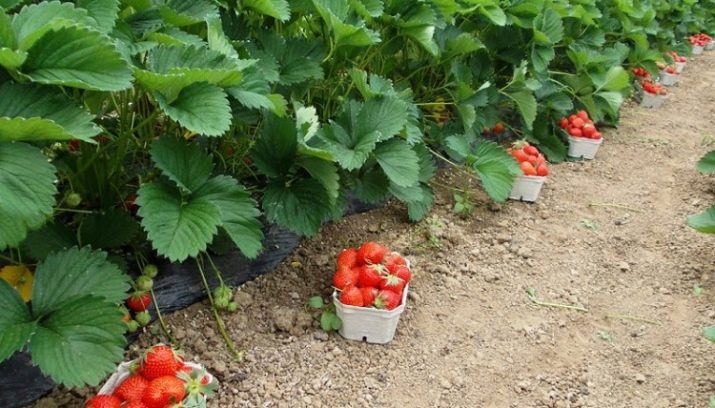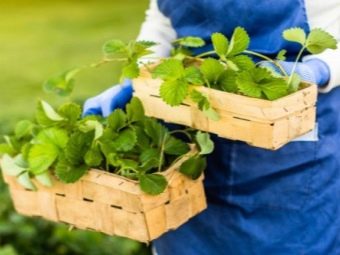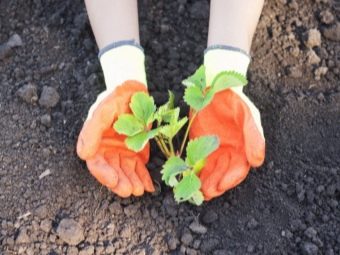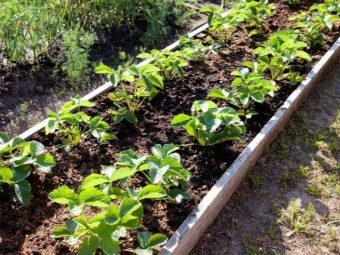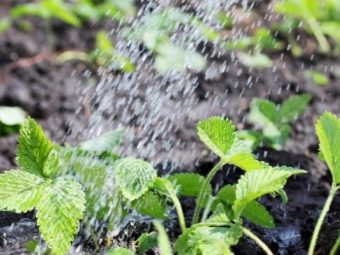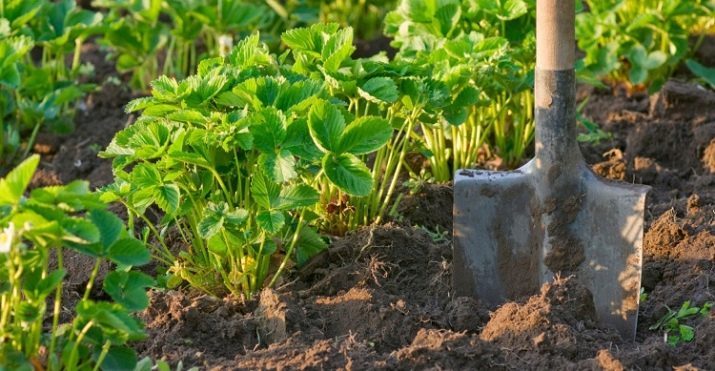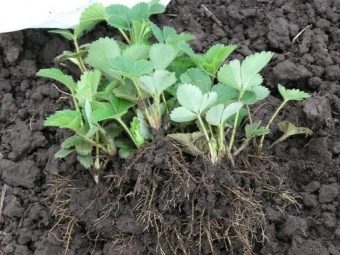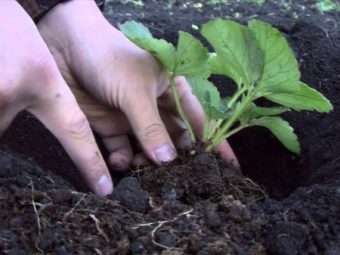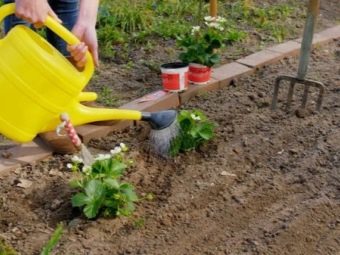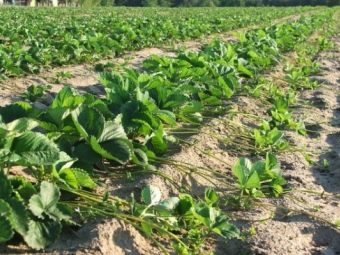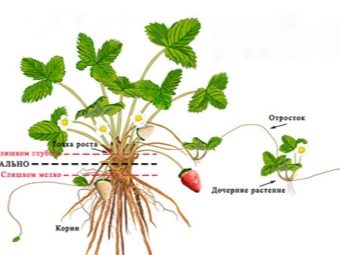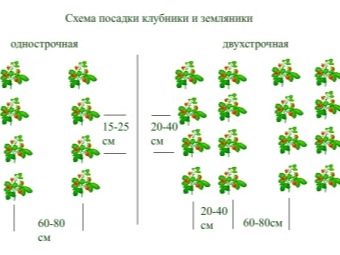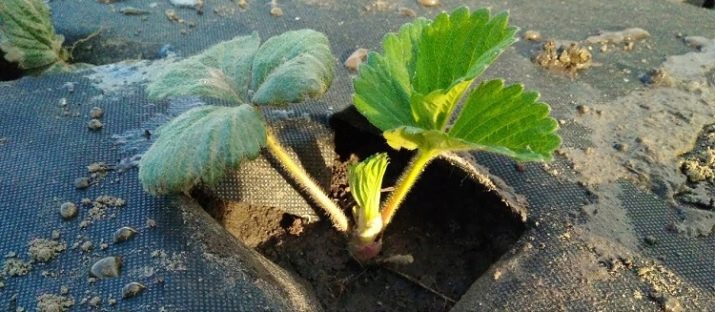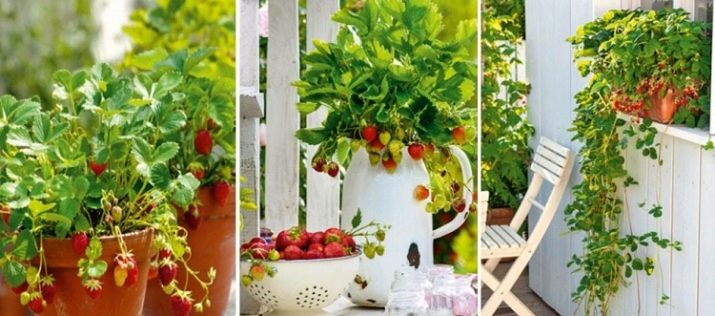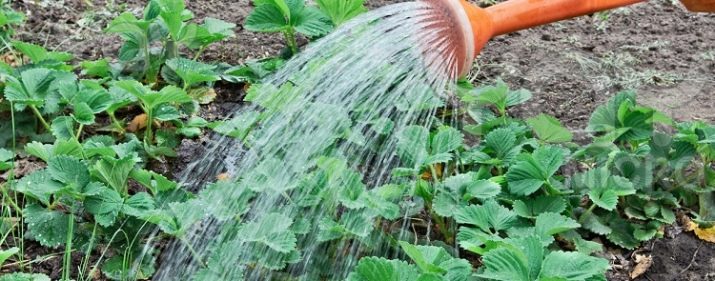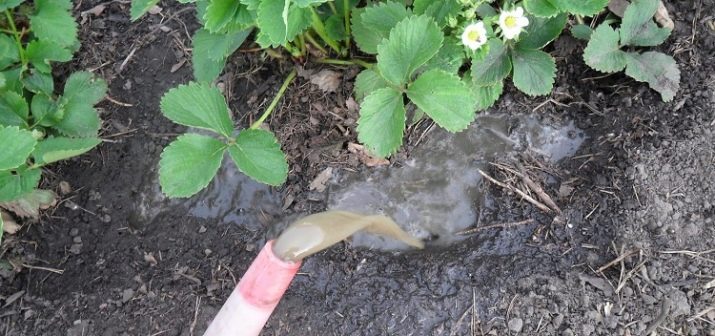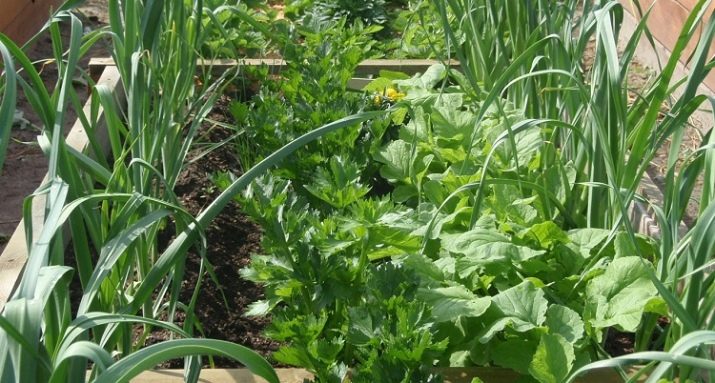The subtleties of the process of planting strawberries in the summer
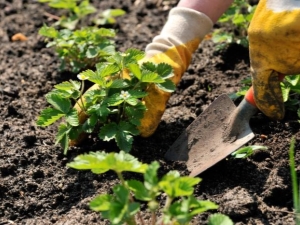
Strawberry "Garden" - is the most common berry, which is grown almost all as in private plots, and in industrial quantities. In the people this culture can be called still strawberry. The plant differs in unpretentiousness in leaving, well transfers low temperatures and droughts, gives a sufficient crop, and berries differ in taste and aroma.
Advantages and disadvantages
Gardeners with experience know all the secrets of how to grow this crop, and therefore for many years quite a large harvest of berries from their plots each year receive. Often the culture can grow in the wild, bringing a small amount of fruit. If, however, provide strawberry special care, as well as attention, then you can get several times more yield.
Peculiarities of care are timely watering, fertilizing the soil, protection from pests and frost. It is recommended to replant young bushes after three or four years of fruiting. When the specified period passes, the berry begins to degenerate, as the bush grows old and becomes weaker, which is the cause of its defeat by various diseases. In this case, the berries will become smaller in size, and they will appear a small amount.
The virtue of this culture is that The transplant is done in summer, spring or autumn, but it should be warm outside. The downside is that with inadequate care, the culture may be affected by diseases, which will cause infection not only of the plants that are planted nearby, but also of the soil. Although this applies not only to the rules of care for strawberries, but also to all plants planted in an open area.
Summer resident should constantly care for his garden, as well as to ensure that it does not spread weeds, which will help all crops to bring great harvests, and not be affected by diseases. It is recommended to periodically spray strawberries, the timing of such activities depend on the region of cultivation.
Timing
All berry crops are demanding to environmental conditions. Strawberries can tolerate frosts and temperatures dropping to 20 degrees, if the shrub is additionally covered with mulch or foil. In the snowy winters, strawberries can withstand frosts and 35 degrees.
If there are spring frosts in the region during the flowering of strawberries, this can cause the flowers to freeze out, and therefore you can lose part of the crop. In this regard, it is recommended to purchase the most suitable variety of strawberries for each region in order to grow it.
The plant also loves the light of the sun, but can grow in shady places. It is recommended to choose areas for strawberries on the hills, where the groundwater is deep, and there is also the possibility of wind blowing.
Strawberries require moisture in the soil. This allows her to obtain nutrients from it. But it should be remembered that the culture does not like the excess water in the soil. Therefore, it is recommended not to re-moisten it, but also not to let it dry, which will negatively affect not only the quantity and quality of berries, but also the condition of the whole bush.
All these points are recommended to be observed and adjusted depending on the growing conditions.
From the time of planting depends on the amount of the crop. In central Russia you can land in May, and in April in the south. The disadvantage of the spring disembarkation is that the plants do not have time to harden before the moment of fruiting. Therefore, the best option is planting seedlings in the fall with the obligatory introduction of the required amount of top dressing in the ground. This will help the bushes to strengthen during the winter under the snow, and in the spring, when it is warm, to begin their livelihoods.
No less popular is the landing in summer. At this point, it is recommended to plant bushes on shaded beds, as well as water them abundantly, so that the culture will strengthen and take strong roots until next season.
Planting strawberries in summer should be carried out correctly, focusing on the specifics of the weather conditions in the areas of residence, since the planting dates of this crop depend on this, which may differ. In the Moscow region, it is recommended that the planting be carried out in the last days of August, which will enable the seedlings to develop well and settle down before the onset of cold weather.
In the Urals, planting is done at the beginning of August, since in this region cold weather is established earlier, and therefore the seedling must be given extra time so that they can get stronger before the onset of cold weather. Gardeners do not set specific dates for planting strawberries in summer, but recommends focusing on the beginning and end of August.
Selection of varieties and seedlings
To choose the seedlings correctly, it is necessary to pay attention to such moments:
- Sockets should be squat and have a central kidney - this is the best instance for landing on an open area. With such bushes you can get up to 200 grams of berries with proper care.
- You need to choose fully formed bushes that have up to 5 healthy sheets. There should be no damage or stains on the bush.
- If you have to buy flowering seedlings, then you need to choose the one that has large flowers.
If there is no opportunity to purchase high-quality and healthy plants, you can plant and weak, but it is worth considering that they will bring less yield, and also often be affected by pests or diseases.
In order to determine which variety will be optimal for cultivation on your plot, it is recommended to plant several types of strawberries in several seedlings at once, and to give preference to one or another variety from the results of fruiting.
The roots
Reusable summer seedlings must have healthy roots, which must be considered when choosing. The length should be at least 5 centimeters, and the color should be light. If the roots are dark, then it says about the diseases of culture. When planting such a plant, the berries from it will be small in size, since they will not be able to get enough nutrients from the soil.
Prevention
When the strawberry is selected and brought home, it is necessary to cut it and disinfect it. To do this, heat the water to 50 degrees and immerse the seedlings there for 20 minutes. After half an hour, this procedure must be repeated. The bulk of pests die in warm water.
In order to prevent diseases, it is also necessary to dip the roots for 7 minutes into the solution of vitriol, salt and water. To do this, it is recommended to take 5 grams of vitriol, 30 g of salt and dilute them in a bucket of water.
Site preparation and soil
Plantation for strawberries should be formed gradually. Summer residents recommend for the first time to plant at one site several plants that differ in age. Periodically and annually it is necessary to lay new beds, planting young plants there.
Old bushes are removed, and a plot is prepared for the young, who will be planted for the next season. In order for the bed to be optimally prepared for the moment of disembarkation, it is recommended to start carrying out all the activities and fertilizing in 30-40 days. After that, it is recommended to dig a garden to a depth of 20 cm and, if necessary, sprinkle with black soil on top.
Strawberries do not like salty soil, and therefore fertilizers are recommended to be applied prematurely, and not just before planting. You need to add a little fertilizer to make the best impact. If necessary, you can periodically add additional fertilizer throughout the season.
Each fertilizer is applied depending on the composition of the soil. If the acidity of the soil is large, then it must be sprinkled with hydrated lime or flour, at the rate of 3 kg of raw material per square meter. Next, it all rolls over. Alkaline open ground is recommended to acidify. For this you need to make there peat or saltpeter.
Scheme and landing technique
Currently, there are many different strawberry planting patterns, but the most favorable one is the planting in twin rows with a small distance between individual bushes, as well as wide gaps between the rows. It is possible to plant in other ways, but experienced gardeners note that it is possible to plant strawberries correctly to obtain a large crop only in the manner indicated above.
The step-by-step instruction states that the bushes should be placed at a distance of 20 cm from each other, and the gap between rows should be up to 70 cm. The aisle should not be compacted. Depending on the conditions of care and cultivation to determine the effectiveness of this method of planting can be at harvest time, making adjustments.
A more compacted fit is suitable for young seedlings. It should be placed in the ground at a distance of 15 cm between the bushes, and there should be a space of 60 cm between the rows. If early strawberries are planted, the distance between the bushes should be 30 cm. This will help the plant to get more nutrients from the soil and give greater yields.
If different varieties of strawberries grow in one area, then a distance of about 80 cm should be made between rows so that the antennae do not intertwine with each other.
Landing technique
It is recommended to disembark according to the following rules:
- Heart seedlings located at ground level.
- When planting young seedlings should abandon fertilization in the hole.
- The roots should be straightened so that they are freely placed in the hole.
- The pits are shed with water, the bushes are dipped into the silt and sprinkled with earth.
Landing on agrofibre
This method can also be planted strawberries. To do this, observe the following sequence:
- prepare the soil and lay on it agrofibre;
- fasten the canvas along the edges;
- define a place for bushes;
- make cuts on the film;
- plant bushes in them;
- water the garden.
Landing at home
If necessary, strawberries can be planted at home. To do this, use large pot, and the soil can be purchased at the store. This is a specialized composition, which has all the necessary components, and therefore does not require any additional events.
For planting at home, it is recommended to buy mutually-pollinated varieties, and the landing time is summer or early autumn. It is worth noting that at home planting strawberries will be more ornamental plants, but at the same time you can get berries several times a year.
Aftercare
Watering
After planting young seedlings they need to be looked after during the first months. Most care is watering, but in this case, you should not overdo it, because the roots can begin to rot from an overabundance of moisture. It must be remembered that the water during watering should fall under the root, and not on the plant itself, as the bush may die.
Normally separated water is used for irrigation, which is heated to a temperature of 20 degrees. Watering is done in the morning, when it is not very hot. In the rainy season, the amount of watering should be reduced depending on the condition of the soil.
Strawberries are especially in need of moisture at the time of the appearance of the fruit. Here, too, when watering, it is necessary to avoid that water gets on the berries or leaves. It is necessary to refuse frequent watering with a small amount of water. It is recommended to give more water at a time, but at the same time reduce the frequency of irrigation.
Top dressing
To get a big harvest, it is recommended to periodically feed the crop. You can make various types of fertilizers, among which both mineral and organic. It may be:
- Litter.
- Compost.
- Humus.
You can add drugs based on phosphorus, potassium, nitrogen, magnesium, and so on. This will help the berries to be more beautiful in appearance, as well as improve their taste.
Top dressing of strawberry is made several times in a season. The first time is feeding in the preparation of the soil, the second time - when harvesting, and the third - in the fall, when the plant is preparing for winter.It should be remembered that the feeding must be completed before the end of September. All components must be diluted in water, so that they fall into the soil in liquid form, but do not overdo it, so that the plants do not get stung. All nutritional formulations are brought under the roots so that they do not fall on the leaves. The optimal concentration of any drug of organic origin is 1 part per 10 liters of water.
Mineral preparations must be diluted in accordance with the requirements on the package.
Common Mistakes and Gardeners Tips
Experienced gardeners say that strawberries grow well, it is recommended not to leave them in one place for more than 4 years in a row. It is necessary to alternate the beds with the planting of other cultures on them. Strawberry predecessors can be:
- Cabbage.
- Legumes
- Garlic.
- Radish.
- Bow.
Another recommendation from experienced gardeners says, do not plant a crop in those areas where there were tomatoes or potatoes, as well as pumpkin.
The mistake of many novice gardeners is that they plant a crop at an inappropriate time of day, which negatively affects its subsequent growth and development. Need to abandon the landing and in hot weather. It is recommended to plant seedlings in the evening or on an overcast day, which will allow moisture to remain longer in the ground and also settle down to the bushes in a new place faster.
Some gardeners add different types of fertilizer to the wells when planting young shoots. But this is a mistake, since it is not necessary to apply fertilizers during this period, they can harm young steam plants. It is recommended to apply top dressing to the site in advance or at the moment when the ovary appears on the strengthened steam trays. Knowing these moments, everyone will be able to cope with the planting of strawberry seedlings in the summer period correctly.
In the next video you are waiting for the rules of proper planting of strawberries in the summer.

